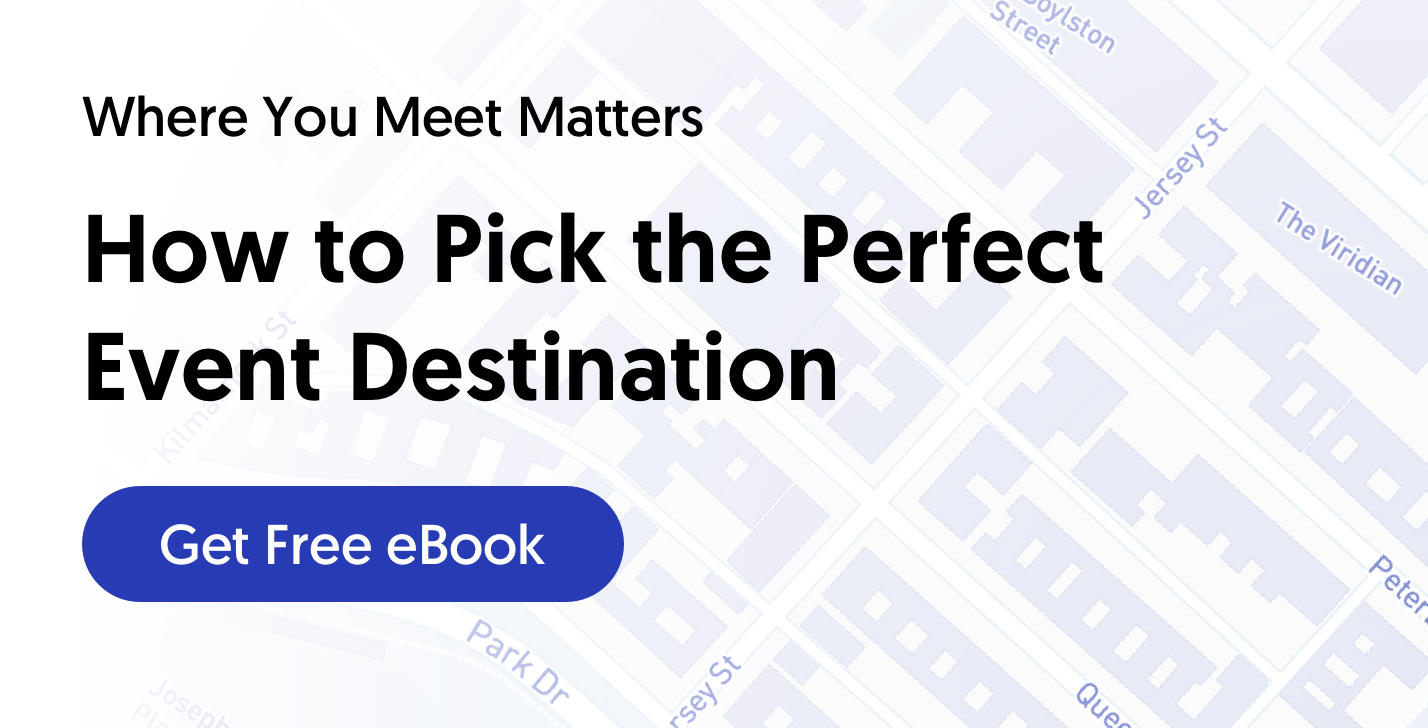
How to Create Better Networking Moments at Events
Did you know that 85% of job openings are filled through face-to-face networking? With statistics like that, it’s no wonder why networking events continue to grow in popularity. Here are some great examples of impactful networking events from leading brands along with ideas you can apply to your next affair.
3 Successful networking event examples

1. Dreamforce by Salesforce
If you attend this networking event by popular CRM brand Salesforce, you’ll instantly be welcomed into a tight knit community of inspiring and creative professionals just for showing up. They make guests feel like part of the family two ways. First, every participant is referred to as a Trailblazer, which instantly makes them stand out from others in their respective industries. Second, they provide really creative ways for people to stand out within the community itself. For example, their post-event collaborative cookbook features winning recipes submitted by Trailblazers that were then paired alongside relevant apps.
So remember – the aim of every networking event should be to create a community and use unique ways to bring people together before, during, and after the event itself.
2. Volunteer Day at the Forbes Under 30 Summit
The Forbes Under 30 Summit is massive. Which is why factoring in some time for attendees to bond with one another is so important to the brand. This is one of the many great reasons why they continue to hold their Volunteer Day.
Attendees who participate get to meet like minded individuals while helping improve the communities that surround the event. From park clean ups to child mentoring, attendees get to make an impact on the lives of those around them in more than one way. And because an activity like volunteering requires a specific personality type and demeanor, it’s no wonder why past participants have bonded together so closely.
It just goes to show, as long as you are creating a positive experience for like minded people, almost any activity can be considered a successful networking opportunity.
3. The After Party at Unbounce’s Call to Action Conference
After a long weekend of attending lectures and learning from the industry’s best and brightest, attendees at this conference get to indulge in some casual networking at the official After Party. Held at a unique local tavern or bar, the event centers on great food, beverages, and more than one kind of photo op. They use branded step and repeats as well as an event hashtag to help promote the affair.
When in doubt, a classic networking event with drinks and food can be all you need to bond people together. If your event goals center around brand promotion, make sure you include branded event elements like Unbounce did.
As you can tell by now, there are lots of different ways to get people in the same place to meet one another. No matter what your event goals are, the following tips and tricks can help you throw a successful networking soiree.

6 Ways to create impactful networking event moments
1. Choose a networking event style.
How you choose to organize your networking event matters. Whether it’s through creative seating plans or purposeful agendas, it takes more than just a time and place for people to start talking. Encourage attendees to open up by using one of these three popular networking event styles.
Set up speed dating.
The speed networking event style is all about introducing as many different people to each other as possible in a given period of time. It often involves seating individuals across from each other, one on one, in chairs, across a long table, or in bistro style arrangements. Designated partners move to the next position in the order whenever a short interval timer buzzes.
While this style is popular for singles trying to mingle, you can do more than just play Cupid. You’ll be connecting dozens of people in a low pressure and fun setting, allowing them to meet more people than they would on their own. Encourage business card exchanges and LinkedIn connections for those looking to keep in touch after the event.
Create round tables.
This small group scenario is just like how it sounds. Seat your attendees in small groups of 8 or less people and give every table a discussion prompt. You can add an element of competition here by making it a problem solving challenge, using a timer, or presenting awards for the most creative response.
Using this style of networking event puts less pressure on individuals to come up with original talking points. Instead they can get to know one another through an activity that goes beyond the standard where do you do? and where are you from? questions. Plus, if you do go the competition route, you’ll help create friendly rivalries and bonds in a natural and fun way.
Make pre-selected groups.
If you’re interested in doing a round table style networking event but don’t trust attendees to seat themselves, you might want to give the selected groups method a try. To pull this off, you’ll need to assign seats and carefully choose where you place each guest. The more you know about your audience, the better.
Depending on what the goal of your networking event is, you can create groups based on common interests like hobbies, sports teams, or career niche. Or, if you poll your guests ahead of time, you can match up groups based on the goals of your individual attendees. For example, you might have a few college aged attendees who are interested in finding summer internships. Pair them with your tech start up reps who mentioned their need for company growth and expansion in the coming months.
2. Prepare old school name tags.
There’s something wonderfully nostalgic about a sticky paper and Sharpie name tag. Used in every Hollywood version of class reunions, the old school name tag is still a staple for networking events today. They’re great for a few reasons.
First, it makes it easier for people to remember each other’s names, which can be a huge relief to those who find matching names and faces challenging. Second, they’re very convenient. You can find them in almost any pharmacy or convenience store. And as an added bonus, they’re also super affordable.
If you prefer more professional and polished looking name tags, opt to print or create your own ahead of the event. Place them out on a table near the event entrance in alphabetical order so guests can easily find their own. You can even add additional info like their title or a fun fact (like the ones you used to group them if you go the selected groups route).
3. Schedule events in the morning, afternoon, and evening.
If your goal is to make your networking event as convenient as possible, why not hold a variety of event times? Scheduling the same event set up for three different parts of the day makes it easy for prospects to fit the event into their schedule. Removing this barrier for attendance ensures that you’ll have more attendees overall. And with networking events, the more attendees there are, the better their chances at making lots of quality connections.
4. Create a designated networking space.
So planning a networking event is all well and good but what about those times where you need to add networking elements to an already established event? That’s where your networking space comes in. Whether it’s a standalone event or a designated area at a conference or seminar, your networking space should specifically designed to encourage conversation in a relaxing and enjoyable environment.
Try lounge seating to help support mixing and mingling. Or provide a special chill out area for VIPs. You can even designate a section of your bar space to speaker meet and greets, giving participants an opportunity to rub elbows with their favorite presenters. But no matter what you choose to do, make sure you use signage, comfortable seating, and extras like catering or drinks to create the ultimate networking space.
5. Hire event staff to mix and mingle with guests.
It may seem silly at first, but you might want to look into some professional help to make your networking event a success. There are people in the world who are great at starting conversations that are both interesting and entertaining with complete strangers. Find them. Harness their powers.
You might even have some coworkers who are known for their amazing anecdotes or ability to find things in common with everyone they meet. Wrangle them into becoming your designated party promoters at the event. Have them talk to guests, find things out about them, and then introduce people who have those same things in common.
Because it’s their job to do so, they won’t succumb to the pressure of making lasting impressions or trying to win over the entire room. Instead, they can focus on facilitating conversations and matching people up who might not have ever met in the first place.
6. Schedule activities that require active participation.
Sometimes the point of a networking event shouldn’t be to just network. Humans who find themselves in those situations often freeze up, worrying about how they haven’t talked to enough people or feeling a bit sleazy about wanting things from other guests. While we understand that networking isn’t inherently a phony or negative thing, the concept can be a turn off for some folks. Especially if they work in an industry like entertainment or real estate, where others who are lower on the job ladder often use networking events to bug them for favors.
Scheduling activities solves all of these problems. Things like silent auctions or adult bingo tournaments require attendees to focus on something other than themselves, which, ironically, helps them better represent their own interests and character anyway. It also gives people something to talk about regardless or whether or not they work in the same field. And it’s just plain old fun!
Networking event ideas for large groups
A lot of the examples and tactics we’ve mentioned so far work really well with small groups. But what about those times when you have more than 100 attendees to plan for? Here is some inspiration to help you get started with networking events for large groups.
- Use activities to break the crowd up into smaller groups. Robot building competitions and relay races naturally require people to be split into teams. Decide whether you’ll have teams sign up ahead of time or if you’ll create the groups yourself.
- Provide entertainment everyone can enjoy at the same time. A live band, theatrical performance, or runway show are all great activities for large groups. They can also provide fuel for talking points afterwards, allowing attendees to bond after their shared experience.
- Add-on experiences people can do when they are not engaging in the main event. Photo booths and decorate your own cupcake stations make it easy for people to break off into their own cliques or take a quick break from all the action.
Keep these ideas (and the rest of our networking advice) in mind and your next big shindig is sure to be a hit!

Final Thoughts: How to encourage networking at events
At the end of the day, networking events are all about helping people bond over a shared interest or activity. How you facilitate that bond is up to you. The way you format your layout, what activities you choose to do, and how you engage with attendees at every stage creates a holistic experience that will help achieve any and all event goals you set for yourself. Don’t be afraid to get creative or take inspiration from other outstanding networking events, like the ones we mentioned here! Check out this post for more examples of great event marketing.

